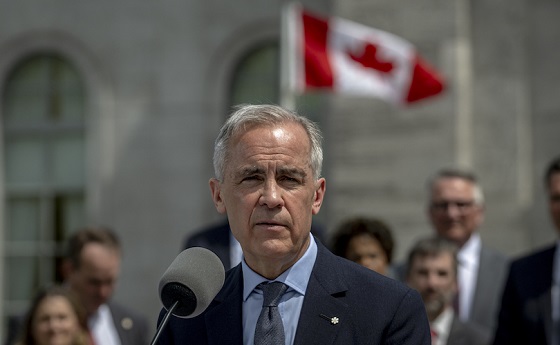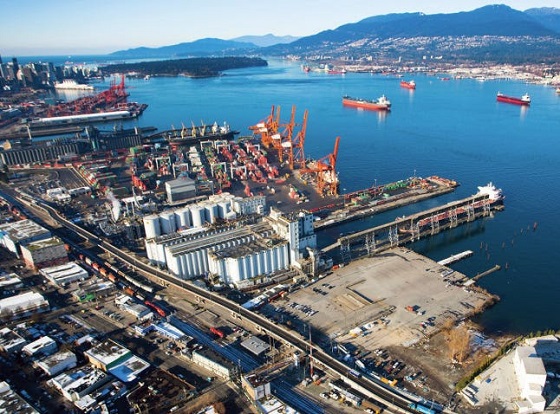Business
USAID funnelled $472 million into Soros-backed media censorship group: report

From LifeSiteNews
A newly released Wikileaks report has revealed that the beleaguered U.S. Agency for International Development directed almost half a billion dollars to Internews, a left-wing media training non-profit group founded by a self-described Marxist activist.
The controversial U.S. Agency for International Development (USAID) directed more than $472 million to an international media non-profit that promotes left-wing narratives and endorses censorship of so-called “disinformation,” according to a recent Wikileaks report.
The Internews Network describes its mission as providing everyone with “trustworthy news and information to make informed decisions,” by “train[ing] journalists and digital rights activists, advanc[ing] internet freedom, and offer[ing] business expertise to help media companies become financially sustainable.” It boasts offices in 30 nations and support for “independent” media in more than 100.
In 2014, NewsBusters reported that Internews was “was founded by a self-described Marxist anti-war protester” and had gotten the vast majority of its revenue from government grants through programs such as USAID, although leftist financier George Soros also donated millions to it.
On February 7, Wikileaks reported that Internews had received $472.6 million from USAID alone as of 2023, that year producing “4,799 hours of broadcasts reaching up to 778 million people” through 4,291 different media outlets, as well as training more than 9,000 journalists.
During a 2023 World Economic Forum (WEF) panel in Davos, Switzerland, Internews President and CEO Jeanne Bourgault declared that “gendered disinformation” was “one of the most terrifying” types of online “misinformation,” which platforms had a responsibility to police through “content moderation,” and advertisers had an obligation to pressure platforms to restrict in thee name of “help[ing] democracy.”
Bourgault expressed similar sentiments at Davos the following year, arguing that “disinformation makes money and we need to follow that money and we need to work with, in particular, the global advertising industry.” She advocated “exclusion lists or inclusion lists just to really try to … focus their ad dollars toward” what she called the “good news and information.”
“And those are U.S. news sites that operate on social media. And those are U.S. news sites. This is the basis of lawsuits here in the U.S. like Daily Wire and the Federalist suing the State Department because U.S. news sites are in these advertiser blacklists,” cybersecurity expert and Foundation For Freedom Online Executive Director Mike Benz told podcaster Joe Rogan this week. “This is top-down U.S. government policy from the White House and I’ll show you the documents on that to the White House executive branch agencies like USAID and State.”
The Trump State Department recently issued a 90-day freeze on foreign aid disbursed through USAID, citing millions in waste and ideologically-biased programs. With exceptions for certain food programs and military aid to Israel and Egypt, the pause is meant to give the administration time to conduct a more thorough review of foreign aid to determine what permanent cuts should be made.
While presented in the media as simply a source of basic care for the poor and sick, USAID has long funneled millions to waste, frivolity, LGBT activism, abortion promotion, and even groups tied to terrorism.
The pause is part of a broader review of federal executive-branch spending currently being spearheaded by Elon Musk’s Department of Government Efficiency (DOGE) advisory project. Last weekend, a federal judge temporarily blocked the administration from putting USAID employees on paid leave, in what critics are calling a particularly extreme case of judicial overreach.
President Donald Trump also signed an executive order directing federal agencies to stop all attempts to pressure private companies to remove content.
Business
Canada’s economic performance cratered after Ottawa pivoted to the ‘green’ economy

From the Fraser Institute
By Jason Clemens and Jake Fuss
There are ostensibly two approaches to economic growth from a government policy perspective. The first is to create the best environment possible for entrepreneurs, business owners and investors by ensuring effective government that only does what’s needed, maintains competitive taxes and reasonable regulations. It doesn’t try to pick winners and losers but rather introduces policies to create a positive environment for all businesses to succeed.
The alternative is for the government to take an active role in picking winners and losers through taxes, spending and regulations. The idea here is that a government can promote certain companies and industries (as part of a larger “industrial policy”) better than allowing the market—that is, individual entrepreneurs, businesses and investors—to make those decisions.
It’s never purely one or the other but governments tend to generally favour one approach. The Trudeau era represented a marked break from the consensus that existed for more than two decades prior. Trudeau’s Ottawa introduced a series of tax measures, spending initiatives and regulations to actively constrain the traditional energy sector while promoting what the government termed the “green” economy.
The scope and cost of the policies introduced to actively pick winners and losers is hard to imagine given its breadth. Direct spending on the “green” economy by the federal government increased from $600 million the year before Trudeau took office (2014/15) to $23.0 billion last year (2024/25).
Ottawa introduced regulations to make it harder to build traditional energy projects (Bill C-69), banned tankers carrying Canadian oil from the northwest coast of British Columbia (Bill C-48), proposed an emissions cap on the oil and gas sector, cancelled pipeline developments, mandated almost all new vehicles sold in Canada to be zero-emission by 2035, imposed new homebuilding regulations for energy efficiency, changed fuel standards, and the list goes on and on.
Despite the mountain of federal spending and regulations, which were augmented by additional spending and regulations by various provincial governments, the Canadian economy has not been transformed over the last decade, but we have suffered marked economic costs.
Consider the share of the total economy in 2014 linked with the “green” sector, a term used by Statistics Canada in its measurement of economic output, was 3.1 per cent. In 2023, the green economy represented 3.6 per cent of the Canadian economy, not even a full one-percentage point increase despite the spending and regulating.
And Ottawa’s initiatives did not deliver the green jobs promised. From 2014 to 2023, only 68,000 jobs were created in the entire green sector, and the sector now represents less than 2 per cent of total employment.
Canada’s economic performance cratered in line with this new approach to economic growth. Simply put, rather than delivering the promised prosperity, it delivered economic stagnation. Consider that Canadian living standards, as measured by per-person GDP, were lower as of the second quarter of 2025 compared to six years ago. In other words, we’re poorer today than we were six years ago. In contrast, U.S. per-person GDP grew by 11.0 per cent during the same period.
Median wages (midpoint where half of individuals earn more, and half earn less) in every Canadian province are now lower than comparable median wages in every U.S. state. Read that again—our richest provinces now have lower median wages than the poorest U.S. states.
A significant part of the explanation for Canada’s poor performance is the collapse of private business investment. Simply put, businesses didn’t invest much in Canada, particularly when compared to the United States, and this was all pre-Trump tariffs. Canada’s fundamentals and the general business environment were simply not conducive to private-sector investment.
These results stand in stark contrast to the prosperity enjoyed by Canadians during the Chrétien to Harper years when the focus wasn’t on Ottawa picking winners and losers but rather trying to establish the most competitive environment possible to attract and retain entrepreneurs, businesses, investors and high-skilled professionals. The policies that dominated this period are the antithesis of those in place now: balanced budgets, smaller but more effective government spending, lower and competitive taxes, and smart regulations.
As the Carney government prepares to present its first budget to the Canadian people, many questions remain about whether there will be a genuine break from the policies of the Trudeau government or whether it will simply be the same old same old but dressed up in new language and fancy terms. History clearly tells us that when governments try to pick winners and losers, the strategy doesn’t lead to prosperity but rather stagnation. Let’s all hope our new prime minister knows his history and has learned its lessons.
Business
Canadians paid $90 billion in government debt interest in 2024/25

From the Fraser Institute
By Jake Fuss, Tegan Hill and William Dunstan
Next week, the Carney government will table its long-awaited first budget. Earlier this year, Prime Minister Mark Carney launched a federal spending review to find $25 billion in savings by 2028. Even if the government meets this goal, it won’t be enough to eliminate the federal deficit—projected to reach as high as $92.2 billion in 2025/26—and start paying down debt. That means a substantial amount of taxpayer dollars will continue to flow towards federal debt interest payments, rather than programs and services or tax relief for Canadians.
When a government spends more than it raises in revenue and runs a budget deficit, it accumulates debt. As of 2024/25, the federal and provincial governments will have accumulated a total projected $2.3 trillion in combined net debt (total debt minus financial assets).
Of course, like households, governments must pay interest on their debt. According to our recent study, the provinces and federal government expect to spend a combined $92.5 billion on debt interest payments in 2024/25.
And like any government spending, taxpayers fund these debt interest payments. The difference is that instead of funding important programs, such as health care, these taxpayer dollars will finance government debt. This is the cost of deficit spending.
How much do Canadians pay each year in government debt interest costs? On a per-person basis, combined provincial and federal debt interest costs in 2024/25 are expected to range from $1,937 in Alberta to $3,432 in Newfoundland and Labrador. These figures represent provincial debt interest costs, plus the federal portion allocated to each province based on a five-year average (2020-2024) of their share of Canada’s population.
For perspective, it’s helpful to compare debt interest payments to other budget items. For instance, the federal government estimates that in 2024/25 it will spend more on debt interest costs ($53.8 billion) than on child-care benefits ($35.1 billion) or the Canada Health Transfer ($52.1 billion), which supports provincial health-care systems.
Provincial governments too spend more money on interest payments than on large programs. For example, in 2024/25, Ontario expects to spend more on debt interest payments ($15.2 billion) than on post-secondary education ($14.2 billion). That same year, British Columbia expects to spend more on debt interest payments ($4.4 billion) than on child welfare ($4.3 billion).
Unlike other forms of spending, governments cannot simply decide to spend less on debt interest payments in a given year. To lower their debt interest payments, governments must rein in spending and eliminate deficits so they can start to pay down debt.
Unfortunately, most governments in Canada are doing the opposite. All but one province (Saskatchewan) plans to run a deficit in 2025/26 while the federal deficit could exceed $90 billion.
To stop racking up debt, governments must balance their budgets. By spending less today, governments can ensure that a larger share of tax dollars go towards programs or tax relief to benefit Canadians rather than simply financing government debt.
-

 Alberta6 hours ago
Alberta6 hours agoFrom Underdog to Top Broodmare
-

 International17 hours ago
International17 hours agoPrince Andrew banished from the British monarchy
-

 Alberta2 days ago
Alberta2 days agoNobel Prize nods to Alberta innovation in carbon capture
-

 Business1 day ago
Business1 day agoCanada’s attack on religious charities makes no fiscal sense
-

 Business17 hours ago
Business17 hours ago“We have a deal”: Trump, Xi strike breakthrough on trade and fentanyl
-

 Bruce Dowbiggin1 day ago
Bruce Dowbiggin1 day agoGet Ready: Your House May Not Be Yours Much Longer
-

 Crime16 hours ago
Crime16 hours agoCanada Seizes 4,300 Litres of Chinese Drug Precursors Amid Trump’s Tariff Pressure Over Fentanyl Flows
-

 National2 days ago
National2 days agoCanadian MPs order ethics investigation into Mark Carney’s corporate interests













